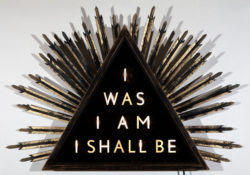Skylar Fein
Largely self-taught and working primarily in wood sculptures, Skylar Fein graphically combines pop-culture icons and revolutionary texts into artwork with embedded political critiques.

Courtesy of Jonathan Ferrara Gallery
The Last Words of Rosa Luxemburg. Fein, Skyler (Artist)
Largely self-taught and working primarily in wood sculptures, Skylar Fein graphically combines pop-culture icons and revolutionary texts into artwork with embedded political critiques. Having moved to Louisiana after Hurricane Katrina, Fein’s rise to prominence in the New Orleans and New York art scenes paralleled the renewed ascendance of New Orleans as a location for artistic experimentation after the levee failures that flooded the city. Fein’s interest in the history of the United States, particularly the history of the South, informs his works and installations. Fein’s approach to history, however, is interpretative rather than documentary, and meant to call the reliability of narratives into question.
Born in New York City in 1968, Fein traveled through the United States, working as a baker outside Seattle, Washington, and a Quaker youth counselor in Philadelphia, Pennsylvania, before settling on his career as an artist. Fein moved to New Orleans just a few weeks before Hurricane Katrina struck in 2005. He arrived with the intention of becoming a medical student, but instead began working with wood, initially building utilitarian objects such as bookshelves. The sale of his bookshelves inspired him to continue object making, and by 2007 he created his first installation at the Phoenix Bar, The Lost Art of Henkin’s Adonis, which presented photos and memorabilia from an imaginary all-male bookstore in New Orleans. This blending of fact and fiction reappeared in his 2008 breakthrough installation, Remember the Upstairs Lounge, which was presented as part of Biennial Prospect.1 New Orleans. In this moving artwork, Fein reconstructed the tragic history of an actual gay bar in the French Quarter, the Upstairs Lounge, where in 1973 an fire set by an arsonist killed more than thirty people trapped upstairs. Fein presented photos and his own artwork in tribute to the victims.
Fein’s first solo museum exhibition in 2009 at the New Orleans Museum of Art, Youth Manifesto, was a vibrant exploration of punk culture from the 1970s and 1980s. Taking the “eternal spirit of youth,” as Fein described his work, and the compelling force of music as its starting point, the sculptures and fabric pieces resembled artifacts of groupie culture such as ticket stubs, flyers, and mix tapes by bands such as The Clash, Adam and the Ants, and the African American punk band Death. A section of the exhibition was also dedicated to graffiti culture, including a lighted homage to the street artist Harsh and a critique of the antigraffiti crusader in New Orleans who goes by the alias Grey Ghost.
Since 2009, Fein has continued to make artworks exploring the spirit of revolution, referencing historical figures such as Rosa Luxemburg and George Bataille. For his 2011 project Bombthreat, Fein invited more than a dozen street artists to collaborate on an elaborate scheme of murals in a sanctioned space in New Orleans.
